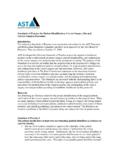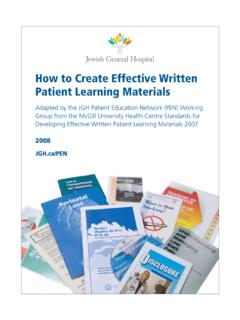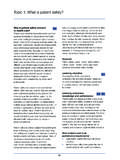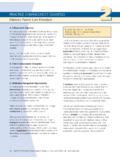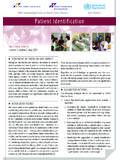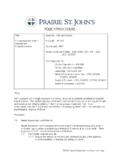Transcription of Approach to the Patient and Patient-Centered Care …
1 KEY TERMS adherenceambulatory carecollaborative practiceevidence-based medicine (EBM)health literacymedication reconciliationmedication therapy management (MTM)OBRA '90polypharmacyprimary careLEARNING OBJECTIVESA fter reading this chapter, the reader should be able to:1. Describe the scope of ambulatory care Give examples of the pharmacist s roles and responsibilities in providing pharmaceutical Describe the elements necessary for applying evidence-based Identify interpersonal characteristics that embody Describe the problems arising from drug therapy management used in the treatment of chronic Describe practice settings in which ambulatory pharmacists Identify regulations impacting the legal responsibilities of pharmacists providing pharmaceutical Compare and contrast traditional pharmacy practice models based on a medication-dispensing role and contemporary practice Describe specialization of skills to meet the needs of special Describe the impact of marginal health literacy on medication Identify the components of the medication therapy management (MTM) to the Patient and Patient -Centered Care ProcessGrace Earl, PharmD, BCPSJ ennifer A.
2 Reinhold, PharmD, BCPS1 CHAPTER 1A definition of ambulatory care practice is provided in Table 1-3. In contemporary pharmacy practice, pharmacists are expanding their role from traditional areas, such as dispensing medication, counseling pa-tients, and providing recommendations for Contemporary practice involves the provision of di-rect Patient care, with a renewed emphasis for phar-macists to be a member of the healthcare This paradigm is supported by the Institute of Medicine, which recognizes the value of an interdisciplinary environment to reduce medication-related errors. In contemporary practice, relationships between pharmacists and a single physician or groups of phy-sicians can be formalized through collaborative prac-tice agreements. The scope of practice is outlined for each provider; for example, once a Patient s medical problem is diagnosed by the physician, the pharma-cist adds or discontinues drug therapy and orders laboratory or other tests to monitor the care pharmacy practice is an inte-grated Approach to Patient care that embraces a part-nership with the During each Patient visit, pharmacists use a structured Approach to interview the Patient to elucidate subjective complaints and to gather objective data, such as vital signs, labora-tory tests, and other test results.
3 Pharmacists per-form physical assessments to evaluate objective signs of disease. The pharmacist Patient partnership is strengthened through encouragement designed to motivate patients to take medications and to make healthy lifestyle changes. Pharmacists should be sensitive to poor literacy abilities and tailor their counseling by using clear language. patients greatly appreciate a pharmacist s efforts to ensure that their medication regimen is affordable and/or covered by health insurance roles and clinical impact of the pharmacist practitioner continue to evolve. One of the most exciting and rapidly growing areas of practice is ambulatory care, the environment in which the overwhelming majority of patients are seen at any given time. Ambulatory care, or the outpatient environment, encompasses not only primary care physician offices but also private clinics and hospital-based outpatient clinics, as well as community pharmacies to some the contemporary model of pharmacy practice, ambulatory care pharmacists are involved in optimizing medication therapy outcomes while engaging with other healthcare professionals (see Table 1-1).
4 Pharmacists working under a collaborative practice agreement with a physician have autonomy to engage in these practices within a defined scope of practice. A pharmacist can interview the Patient to assess reasons for medication nonadherence, such as lack of understanding or affordability issues. In addi-tion, the pharmacist can recommend immunizations that may be necessary to prevent further health prob-lems. As the depth and breadth of clinical pharmacy education expands, so do the opportunities for phar-macists to be engaged in improving medication ther-apy, promoting safe use of medications, and assisting patients in gaining access to care. DEFINING THE SCOPE OF AMBULATORY CARE PHARMACY PRACTICEA mbulatory care involves providing healthcare ser-vices to patients who are able to walk, or ambulate, to the healthcare This provides the setting for provision of pharmaceutical care to promote health maintenance and prevention as well as to manage medication therapy for individuals with chronic dis-eases.
5 Pharmacists have established a role in primary care ambulatory practice settings as well as targeted disease-focused clinics. patients access primary care services at the initial point of access to receive treat-ment. Primary care treats patients with a broad range of ages and medical problems, and the practitioner assumes responsibility for referral and follow-up to other specialists (see Table 1-2). Ambulatory care practice settings deliver service at stand-alone clinics as well as clinics affiliated with healthcare systems. Table 1-1 Contemporary Model of Pharmacy Practicet Provide pharmaceutical Engage in Patient -centered, outcomes-oriented pharmacy Work with patients and other healthcare Promote Prevent and treat Assess, monitor, initiate, and modify medication : Data from Schlaifer M, Rouse MJ. Scope of contempo-rary pharmacy practice: roles, responsibilities, and functions of pharmacists and pharmacy technicians.
6 J Manag Care Pharm. 2010 Sep;16(7):507 8. 2 Chapter 1 Approach to the Patient and Patient -Centered Care Process Table 1-2 Descriptions of Healthcare ProfessionalsPhysicians: Medical Doctors (MDs) and Doctors of Osteopathy (DOs)t The first year after graduation from medical school the physicians are Residents are doctors who are completing postgraduate training in their second and third years following Interns and residents comprise the house staff in a An attending is an experienced physician who oversees interns and Both MDs and DOs use all accepted forms of medical treatment, including drug therapy and DOs emphasize holistic and preventive Assistants (PAs)t Physicians may delegate medical duties to the PA that are within the physician s scope of practice and within the PA s training and PAs may work on a physician PA team in medical and surgical Nurses practice independently within their own defined scope of Nursing roles range from providing direct Patient care to managing cases, establishing nursing practice standards, developing quality assurance procedures, and directing complex nursing care Expanding roles of nurses: t Nurse practitioners (NPs) conduct physical exams; diagnose and treat common acute illnesses and injuries; provide immunizations; and manage high blood pressure, diabetes, and other chronic problems.
7 T Clinical nurse specialists (CNSs) provide specialized care such as cardiac, oncology, neonatal, and obstetric/gynecological nursing. t Certified nurse-midwives (CNMs) provide prenatal and gynecological care to normal, healthy women; deliver babies; and offer postpartum Therapists (PTs)t Physical therapists provide therapies to improve the mobility of a person with physical disabilities, to relieve pain, and to prevent or limit the extent of a physical Requires a masters degree or Therapists (RTs)t Care for patients with breathing or cardiopulmonary Minimum certification is the Certified Respiratory Therapist (CRT).t Advanced certification is the Registered Respiratory Therapist (RRT).Occupational Therapist (OTs)t Provide therapies to improve the Patient s ability to perform tasks in living and working environments. t Use treatments to develop and recover the skills the Patient needs for daily living and : Data from Office of Occupational Statistics and Employment Projections.
8 Occupational outlook handbook [Internet]. Washington, DC: Bureau of Labor Statistics; 2010. [cited Feb 10, 2012]. Available from: # care arose because of the need to manage patients with chronic diseases that are treat-able but not curable. Data collected in 2005 by the National Center for Chronic Disease Control and Health Promotion report that one in two individuals report having a chronic Pharmacists are likely to schedule visits with patients to provide med-ication therapy management (MTM) and preven-tive care strategies and to manage drug-related issues stemming from cardiovascular disease, chronic lower Defining the Scope of Ambulatory Care Pharmacy Practice 3respiratory disease, and other areas. Ambulatory care involves managing Patient issues regarding primary diseases, such as diabetes mellitus, as well as compli-cations of diabetes, such as kidney can use their clinical expertise to op-timize medication therapy that ultimately meets the current demand for effective and efficient coordina-tion of care.
9 The definition of pharmaceutical care by Hepler and Strand emphasizes the pharmacist s responsibility to improve the Patient s quality of life (see Table 1-4).5 The elements of care are aimed at improving the Patient s immediate needs, such as improving the symptoms of disease. For example, patients with uncontrolled diabetes may experience symptoms of thirst caused by elevated blood glucose levels. By recognizing the significance of these symp-toms while interviewing the Patient , the pharmacist takes steps to design a plan to advance the doses of Table 1-4 Definition of Pharmaceutical Care.. the responsible provision of drug therapy for the purpose of achieving specific outcomes that improve a Patient s quality of life. These outcomes are: t Curing of a diseaset Elimination or reduction of a Patient s symptoms t Arresting or slowing of a disease process t Preventing a disease or symptomsSource: Data from Hepler CD, Strand LM.
10 Opportunities and responsibilities in pharmaceutical care. Am J Hosp Pharm. 1990 Mar;47(3):533 medications or recommend new medica-tion combinations. Using evidence-based medicine, a new drug regimen is chosen to lower blood glucose and achieve the desired target for hemoglobin also consider drug therapy aimed at meeting long-term goals, such as reducing hospital-ization and morbidity and mortality. Pharmacists must be aware that patients may place a higher value on medications that relieve symptoms of dis-ease rather than producing long-term benefits, such as reducing hospitalizations or prolonging For example, a Patient with heart failure may routinely take a diuretic dose to treat symptoms of edema. Most patients know that loop diuretics reduce signs of edema and improve symptoms associated with fluid retention. Often, they refer to these drugs as their water pills. However, they may periodically skip doses or delay refilling prescriptions of other heart failure treatments because they perceive the medications to be unnecessary.











